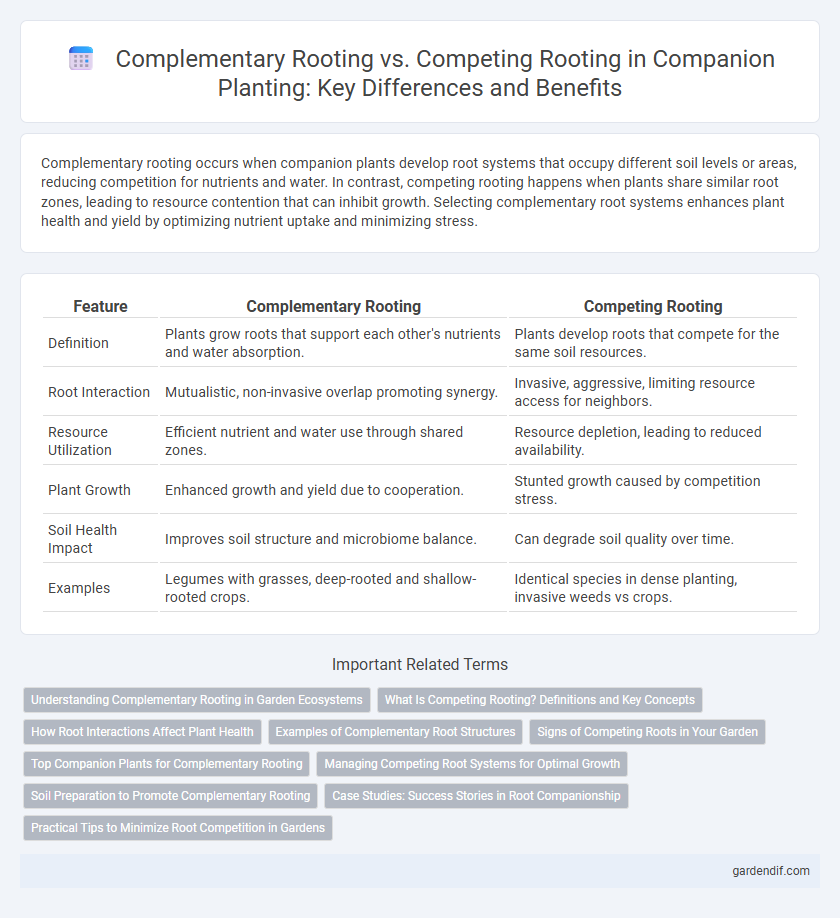
Complementary rooting vs competing rooting Illustration
Complementary rooting occurs when companion plants develop root systems that occupy different soil levels or areas, reducing competition for nutrients and water. In contrast, competing rooting happens when plants share similar root zones, leading to resource contention that can inhibit growth. Selecting complementary root systems enhances plant health and yield by optimizing nutrient uptake and minimizing stress.
Table of Comparison
| Feature | Complementary Rooting | Competing Rooting |
|---|---|---|
| Definition | Plants grow roots that support each other's nutrients and water absorption. | Plants develop roots that compete for the same soil resources. |
| Root Interaction | Mutualistic, non-invasive overlap promoting synergy. | Invasive, aggressive, limiting resource access for neighbors. |
| Resource Utilization | Efficient nutrient and water use through shared zones. | Resource depletion, leading to reduced availability. |
| Plant Growth | Enhanced growth and yield due to cooperation. | Stunted growth caused by competition stress. |
| Soil Health Impact | Improves soil structure and microbiome balance. | Can degrade soil quality over time. |
| Examples | Legumes with grasses, deep-rooted and shallow-rooted crops. | Identical species in dense planting, invasive weeds vs crops. |
Understanding Complementary Rooting in Garden Ecosystems
Complementary rooting enhances garden ecosystems by allowing plants with different root depths and structures to coexist, optimizing nutrient and water uptake. This synergy reduces competition for resources, promotes soil health, and supports biodiversity. Understanding these interactions enables gardeners to select plant combinations that improve growth and resilience naturally.
What Is Competing Rooting? Definitions and Key Concepts
Competing rooting occurs when the roots of companion plants vie for the same soil nutrients, water, and space, leading to competition rather than mutual benefit. This phenomenon can hinder plant growth and reduce overall garden productivity due to resource depletion. Understanding the distinction between competing rooting and complementary rooting is essential for effective companion planting and optimizing plant health.
How Root Interactions Affect Plant Health
Complementary rooting enhances plant health by promoting efficient nutrient and water uptake through spatially distinct root zones, reducing competition and stress. Competing rooting, however, leads to resource overlap and imbalance, causing nutrient deficiencies and stunted growth. Understanding these root interactions is essential for optimizing companion planting strategies to improve overall plant vigor and resilience.
Examples of Complementary Root Structures
Complementary rooting involves plant species with root systems that occupy different soil depths or exploit distinct nutrient zones, such as deep-rooted alfalfa paired with shallow-rooted grasses. This synergistic arrangement enhances resource utilization and reduces direct competition for water and nutrients. Trees like mesquite with taproots alongside fibrous-rooted grasses illustrate effective complementary rooting in agroforestry systems.
Signs of Competing Roots in Your Garden
Signs of competing roots in your garden include stunted growth, yellowing leaves, and wilting plants despite adequate watering. Roots that aggressively spread crowd neighboring plants, restricting access to water and nutrients, leading to poor overall plant health. Observing exposed, intertwined roots on the soil surface also indicates competition, which can ultimately diminish the productivity of your garden.
Top Companion Plants for Complementary Rooting
Top companion plants for complementary rooting include legumes such as clover and beans, which enrich soil nitrogen while supporting neighboring crops like corn and tomatoes. Deep-rooted plants like carrots and parsnips improve soil aeration and nutrient access without competing directly with shallow-rooted companions like lettuce and spinach. This symbiotic root system optimizes soil health, enhances nutrient cycling, and boosts overall garden productivity.
Managing Competing Root Systems for Optimal Growth
Managing competing root systems requires strategic spatial planning to ensure optimal nutrient uptake and growth. Companion planting with complementary rooting patterns maximizes soil resource utilization by pairing deep-rooted plants with shallow-rooted species, reducing root competition. Effective root management enhances plant health, improves soil structure, and increases overall yield by minimizing root overlap and competition for water and nutrients.
Soil Preparation to Promote Complementary Rooting
Optimizing soil preparation promotes complementary rooting by enhancing nutrient availability and improving soil structure, which encourages diverse root growth patterns and reduces direct competition among plants. Techniques such as deep tilling, organic matter incorporation, and targeted pH adjustment create an ideal environment for roots to explore different soil depths and niches. This strategic preparation supports symbiotic relationships and maximizes resource uptake, fostering healthier companion planting systems.
Case Studies: Success Stories in Root Companionship
Case studies in root companionship reveal that complementary rooting enhances nutrient uptake and improves soil structure by allowing different plant species to access distinct soil layers, as seen in legume-grass intercropping systems. Success stories include alley cropping with deep-rooted trees and shallow-rooted crops, leading to increased biomass and higher yields due to optimized water and nutrient partitioning. In contrast, competing rooting often results in reduced growth and lower productivity, highlighting the importance of selecting compatible species for effective root companionship.
Practical Tips to Minimize Root Competition in Gardens
To minimize root competition between complementary plantings, implement deep mulching to retain soil moisture and suppress weeds, which supports root health and nutrient uptake. Use staggered planting depths to ensure that roots access different soil layers, reducing direct competition for water and nutrients. Regularly monitor soil moisture and nutrient levels, adjusting irrigation and fertilization to meet the specific needs of each companion plant for optimal growth.
Complementary rooting vs competing rooting Infographic

 gardendif.com
gardendif.com